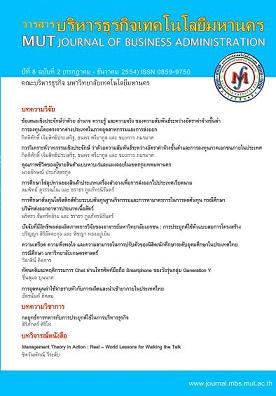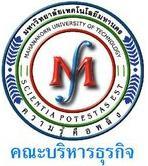ปัจจัยที่มีอิทธิพลต่อผลิตภาพการวิจัยของอาจารย์มหาวิทยาลัยเอกชน : การประยุกต์ใช้ตัวแบบสมการโครงสร้าง
Keywords:
ผลิตภาพการวิจัย, ตัวแบบสมการโครงสร้าง, อาจารย์มหาวิทยาลัยเอกชน, Research Productivity, Structural Equation Modeling, Lecturers in Private UniversitiesAbstract
การวิจัยครั้งนี้เป็นการศึกษาความสัมพันธ์เชิงสาเหตุ โดยมีวัตถุประสงค์ 1) เพื่อศึกษาผลิต ภาพการวิจัยของอาจารย์มหาวิทยาลัยเอกชน 2) เพื่อเปรียบเทียบผลิตภาพการวิจัยของอาจารย์ มหาวิทยาลัยเอกชน จำแนกตามระดับการศึกษา และตำแหน่งทางวิชาการ และ 3) เพื่อพัฒนาและ ตรวจสอบความสอดคล้องของตัวแบบความสัมพันธ์เชิงสาเหตุของผลิตภาพการวิจัยของอาจารย์ มหาวิทยาลัยเอกชนที่ผู้วิจัยพัฒนาขึ้นกับข้อมูลเชิงประจักษ์ ตัวแปรที่ใช้ในการวิจัยครั้งนี้ประกอบด้วยตัว แปรสาเหตุ 9 ตัวแปร ได้แก่ เพศ อายุ ระดับการศึกษา ตำแหน่งทางวิชาการ ประสบการณ์ทำงาน ฐานะ ทางเศรษฐกิจ คุณลักษณะสถานศึกษาที่เอื้อต่อการทำวิจัย ความเป็นนักวิจัย และสมรรถภาพการวิจัย ตัวแปรผล 1 ตัวแปร คือ ผลิตภาพการวิจัย ตัวอย่างที่ใช้ในการวิจัย คือ อาจารย์ประจำในมหาวิทยาลัย เอกชนที่มีผลการดำเนินงานด้านการทำวิจัยในกลุ่มสาขาวิชาสังคมศาสตร์ และกลุ่มสาขาวิทยาศาสตร์ อย่างน้อย จำนวน 1 เรื่อง จำนวน 120 คน ใช้วิธีการสุ่มตัวอย่างด้วยวิธีการสุ่มแบบสองขั้นตอน เครื่องมือที่ใช้ในการวิจัย ได้แก่ แบบวัดผลิตภาพการวิจัย แบบวัดคุณลักษณะของสถานศึกษาที่เอื้อต่อ การทำวิจัย แบบวัดความเป็นนักวิจัย และแบบวัดสมรรถภาพการวิจัย วิเคราะห์ข้อมูลด้วยสถิติบรรยายวิเคราะห์ความแตกต่างด้วย t test วิเคราะห์สหสัมพันธ์แบบเพียร์สัน วิเคราะห์องค์ประกอบเชิงยืนยัน และวิเคราะห์ตัวแบบสมการโครงสร้างผลการวิจัย พบว่า
1. ผลิตภาพการวิจัยของอาจารย์มหาวิทยาลัยเอกชนมีคะแนนเฉลี่ยเท่ากับ 12.73 คะแนนต่อ ช่วงระยะเวลา 3 ปี หรือเท่ากับ 4.24 คะแนนต่อปี หรือเท่ากับเฉลี่ย 0.42 เรื่องต่อปี
2. อาจารย์มหาวิทยาลัยเอกชนที่มีวุฒิการศึกษาต่างกันมีผลิตภาพการวิจัยต่างกันอย่างมี นัยสำคัญทางสถิติ ที่ระดับ .01 โดยอาจารย์มหาวิทยาลัยเอกชนที่มีวุฒิการศึกษาระดับปริญญาเอกจะมี ผลิตภาพการวิจัยมากกว่าอาจารย์ที่มีวุฒิการศึกษาระดับปริญญาโท และอาจารย์มหาวิทยาลัยเอกชนที่ มีตำแหน่งทางวิชาการต่างกันมีผลิตภาพการวิจัยต่างกันอย่างมีนัยสำคัญทางสถิติที่ระดับ .05 โดย อาจารย์มหาวิทยาลัยเอกชนที่มีตำแหน่งทางวิชาการเป็นผู้ช่วยศาสตราจารย์จะมีผลิตภาพการวิจัย มากกว่าอาจารย์ที่ไม่มีตำแหน่งทางวิชาการ
3. ตัวแบบความสัมพันธ์เชิงสาเหตุของผลิตภาพการวิจัยของอาจารย์มหาวิทยาลัยเอกชนมี ความสอดคล้องกับข้อมูลเชิงประจักษ์ (χ2 = 62.348, df = 76, p = .870, χ2 /df = 0.820, GFI = .928, NFI = .956, NNFI = 1.000, CFI = 1.000, RMR = .018, SRMR = .049, RMSEA = .000, LSR = 1.889) ตัวแปรในตัวแบบสามารถอธิบายความแปรปรวนของผลิตภาพการวิจัยของอาจารย์ มหาวิทยาลัยเอกชนได้ร้อยละ 34.70 ตัวแปรที่มีอิทธิพลทางตรงสูงสุดต่อผลิตภาพการวิจัย คือ ตัวแปร ประสบการณ์ทำงาน และตัวแปรคุณลักษณะสถานศึกษาที่เอื้อต่อการทำวิจัย ตามลำดับ ตัวแปรผลิต ภาพการวิจัยได้รับอิทธิพลทางอ้อมอย่างไม่มีนัยสำคัญทางสถิติ และตัวแปรที่มีอิทธิพลรวมสูงสุดต่อผลิต ภาพการวิจัย คือ ตัวแปรประสบการณ์ทำงาน และตัวแปรคุณลักษณะสถานศึกษาที่เอื้อต่อการทำวิจัย ตามลำดับ
Factors Affecting Research Productivity of Lecturers in Private Universities : An Application of the Structural Equation Modeling
The purposes of this research were to 1) study research productivity of lecturers in private universities 2) compare the levels of research productivity of lecturers in private universities as classified by educational level and academic rank and 3) study causal relationship, develop and validate consistency with empirical data with the causal relationship model of research productivity of lecturers in private universities. The model consisted of 9 causal variables; gender, age, educational level, academic rank, work experiences, income, institutional support for research work, researchership, and research competence. Dependent variable was research productivity. The sample consisted of 120 lecturers in private universities.
Data were analyzed by descriptive statistics, independent samples t test, Pearson’s correlation coefficient analysis, confirmatory factor analysis, and linear structural equation model analysis.
The results indicated that:
1. The average research productivity of each lecturer in private universities’s was 0.42 pieces per year.
2. There were significant differences at the level of .01 in the research productivity between lecturers in private universities of different educational levels. Lecturers in private universities with doctoral degree had more research productivity than lecturers with master degree. There were significant differences at the level of .05 in the research productivity between lecturers in private universities of different academic ranks. Lecturers in private universities who were assistant professors had more research productivity than instructors.
3. Model was consistent with empirical data as indicated by the good fit indices (χ 2 = 62.348, df = 76, p = .870, χ 2 /df = 0.820, GFI = .928, NFI = .956, NNFI = 1.000, CFI = 1.000, RMR = .018, SRMR = .049, RMSEA = .000 and LSR = 1.889). The variables in the model accounted for 34.70 percent of the total variance of research productivity. The factors which had statistically significant direct effect to research productivity of lecturers in private universities were work experiences and institutional support for research work respectively. Research productivity received no statistically significant indirect effect. And the factors which had statistically significant total direct effect to research productivity of lecturers in private universities were work experiences and institutional support for research work respectively.
Downloads
Issue
Section
License
ข้อความ ข้อคิดเห็น ข้อมูล เนื้อหา รูปภาพ แผนภูมิ แผนผัง เป็นต้น ที่ปรากฏและแสดงในบทความต่างๆ ในวารสารบริหารธุรกิจเทคโนโลยีมหานคร ถือเป็นความรับผิดชอบโดยตรงของผู้เขียนบทความนั้นๆ มิใช่เป็นความรับผิดชอบใดๆ ของวารสารบริหารธุรกิจเทคโนโลยีมหานคร และมหาวิทยาลัยเทคโนโลยีมหานคร
บทความที่ตีพิมพ์ในวารสารบริหารธุรกิจเทคโนโลยีมหานคร ถือเป็นลิขสิทธิ์เฉพาะของคณะบริหารธุรกิจ มหาวิทยาลัยเทคโนโลยีมหานคร หากบุคคลหรือหน่วยงานใดต้องการนำทั้งหมดหรือส่วนใดส่วนหนึ่งไปเผยแพร่ต่อหรือเพื่อกระทำการใดๆ จะต้องได้รับการอนุญาตเป็นลายลักษณ์อักษรจากคณะบริหารธุรกิจ มหาวิทยาลัยเทคโนโลยีมหานครก่อนเท่านั้น


